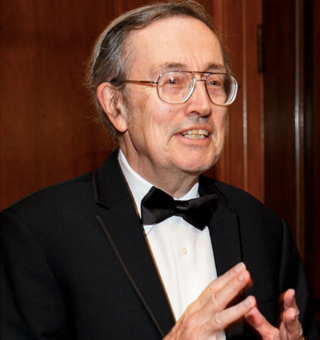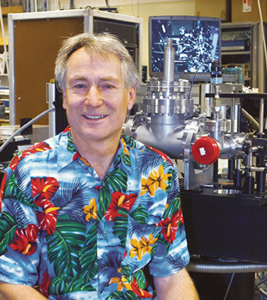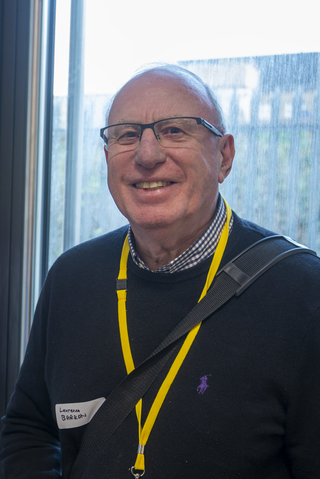Related Research Articles

Sir Michael Victor Berry,, is a mathematical physicist at the University of Bristol, England.

Sir Alan Roy Fersht is a British chemist at the MRC Laboratory of Molecular Biology, Cambridge, and an Emeritus Professor in the Department of Chemistry at the University of Cambridge. He was Master of Gonville and Caius College, Cambridge from 2012 to 2018. He works on protein folding, and is sometimes described as a founder of protein engineering.

Robert Howard Crabtree is a British-American chemist. He is serving as Conkey P. Whitehead Professor Emeritus of Chemistry at Yale University in the United States. He is a naturalized citizen of the United States. Crabtree is particularly known for his work on "Crabtree's catalyst" for hydrogenations, and his textbook on organometallic chemistry.
Herbert Eric Huppert is an Australian-born geophysicist living in Britain. He has been Professor of Theoretical Geophysics and Foundation Director, Institute of Theoretical Geophysics, at the University of Cambridge, since 1989 and Fellow of King's College, Cambridge, since 1970.

John Roy Whinnery was an American electrical engineer and educator who worked in the fields of microwave theory and laser experimentation.

Nader Engheta is an Iranian-American scientist. He has made pioneering contributions to the fields of metamaterials, transformation optics, plasmonic optics, nanophotonics, graphene photonics, nano-materials, nanoscale optics, nano-antennas and miniaturized antennas, physics and reverse-engineering of polarization vision in nature, bio-inspired optical imaging, fractional paradigm in electrodynamics, and electromagnetics and microwaves.

Richard James Saykally is an American chemist. He is currently the Class of 1932 Endowed Professor of Chemistry at the University of California, Berkeley. He has received numerous awards for his research on the molecular characteristics of water and aqueous solutions.

Min Gu is a Chinese-Australian physicist who currently serves as the Executive Chancellor and Professor at the University of Shanghai for Science and Technology. Previously he was Distinguished Professor and Associate Deputy Vice-Chancellor for Research Innovation & Entrepreneurship at RMIT University.
Joseph W. Goodman is an engineer and physicist. He received an A.B. degree in Engineering and Applied Physics from Harvard University in 1958 and M.S. and Ph.D. degrees in Electrical Engineering from Stanford University in 1960 and 1963, respectively. He has held a number of positions in the field of optics, including the presidency of the Optical Society of America in 1992.

Laurence David Barron has been Gardiner Professor of Chemistry at the University of Glasgow since 1998. He is a chemist who has conducted pioneering research into the properties of chiral molecules — defined by Lord Kelvin as those that cannot be superimposed onto their mirror image. By extending this definition of chirality to include moving particles and processes that vary with time, he has made a fundamental theoretical contribution to the field. Chiral molecules such as amino acids, sugars, proteins, and nucleic acids play a central role in the chemistry of life, and many drug molecules are chiral. Laurence’s work on Raman optical activity — a spectroscopic technique capable of determining the three-dimensional structures of chiral molecules, which he predicted, observed, and applied to problems at the forefront of chemistry and structural biology — has led to its development as a powerful analytical tool used in academic and industrial laboratories worldwide. His much-cited book, Molecular Light Scattering and Optical Activity, has contributed to the growing impact of chirality on many areas of modern science.
Richard C. Powell is an American professor emeritus of physics and vice president emeritus of the University of Arizona (UA), whose career focused on research in materials science and laser optics. He served as president of the Optical Society of America in 2000.

David Jeffrey Wineland is an American Nobel-laureate physicist at the National Institute of Standards and Technology (NIST) physics laboratory. His work has included advances in optics, specifically laser-cooling trapped ions and using ions for quantum-computing operations. He was awarded the 2012 Nobel Prize in Physics, jointly with Serge Haroche, for "ground-breaking experimental methods that enable measuring and manipulation of individual quantum systems".
Norman Richard Pace Jr. is an American biochemist, and is Distinguished Professor Emeritus of Molecular, Cellular and Developmental Biology at the University of Colorado. He is principal investigator at the Pace lab.
Jacob Nissim Israelachvili, was an Israeli physicist who was a professor at the University of California, Santa Barbara (UCSB).

Gerald Westheimer AM FRS is an Australian scientist at University of California, Berkeley researching the eye, its optics, and how we see details in space and in three dimensions.

Harold Vincent Poor FRS FREng is the Michael Henry Strater University Professor of Electrical Engineering at Princeton University, where he is also the Interim Dean of the School of Engineering and Applied Science. He is a specialist in wireless telecommunications, signal processing and information theory. He has received many honorary degrees and election to national academies. He was also President of IEEE Information Theory Society (1990). He is on the board of directors of the IEEE Foundation.
Henry W. Hofstetter was an American optometrist and the author of two books and 500 research papers. He is a past president of the American Optometric Association and a member of the National Optometry Hall of Fame.
John Edwin Midwinter OBE FRS FREng was a British electrical engineer and professor, who was President of the Institution of Electrical Engineers from 2000 to 2001.
Arup Kumar Raychaudhuri is an Indian condensed matter physicist, materials scientist and a Distinguished Emeritus Professor at the S. N. Bose National Centre for Basic Sciences. Known for his pioneering work on the interplay of disorder and interaction, Raychaudhuri is an elected fellow of all the three major Indian science academies viz. Indian Academy of Sciences, National Academy of Sciences, India and Indian National Science Academy as well as the Asia-Pacific Academy of Materials. He is a recipient of a number of awards such as Millennium Medal of the Indian Science Congress, ICS Gold Medal of the Materials Research Society of India and FICCI Award. The Council of Scientific and Industrial Research, the apex agency of the Government of India for scientific research, awarded him the Shanti Swarup Bhatnagar Prize for Science and Technology, one of the highest Indian science awards, for his contributions to physical sciences in 1994.
Ann E. Elsner is an American researcher and Distinguished Professor of Optometry, Indiana University Bloomington.
References
- 1 2 "Larry N. Thibos, PhD" . Retrieved September 29, 2013.
- 1 2 "Research Excellence Lecture 2014". February 14, 2014. Archived from the original on March 3, 2009. Retrieved March 15, 2014.
- ↑ "American Academy of Optometry recognizes two from IU for distinguished careers". Indiana University. November 12, 2012. Archived from the original on March 3, 2009. Retrieved March 15, 2014.